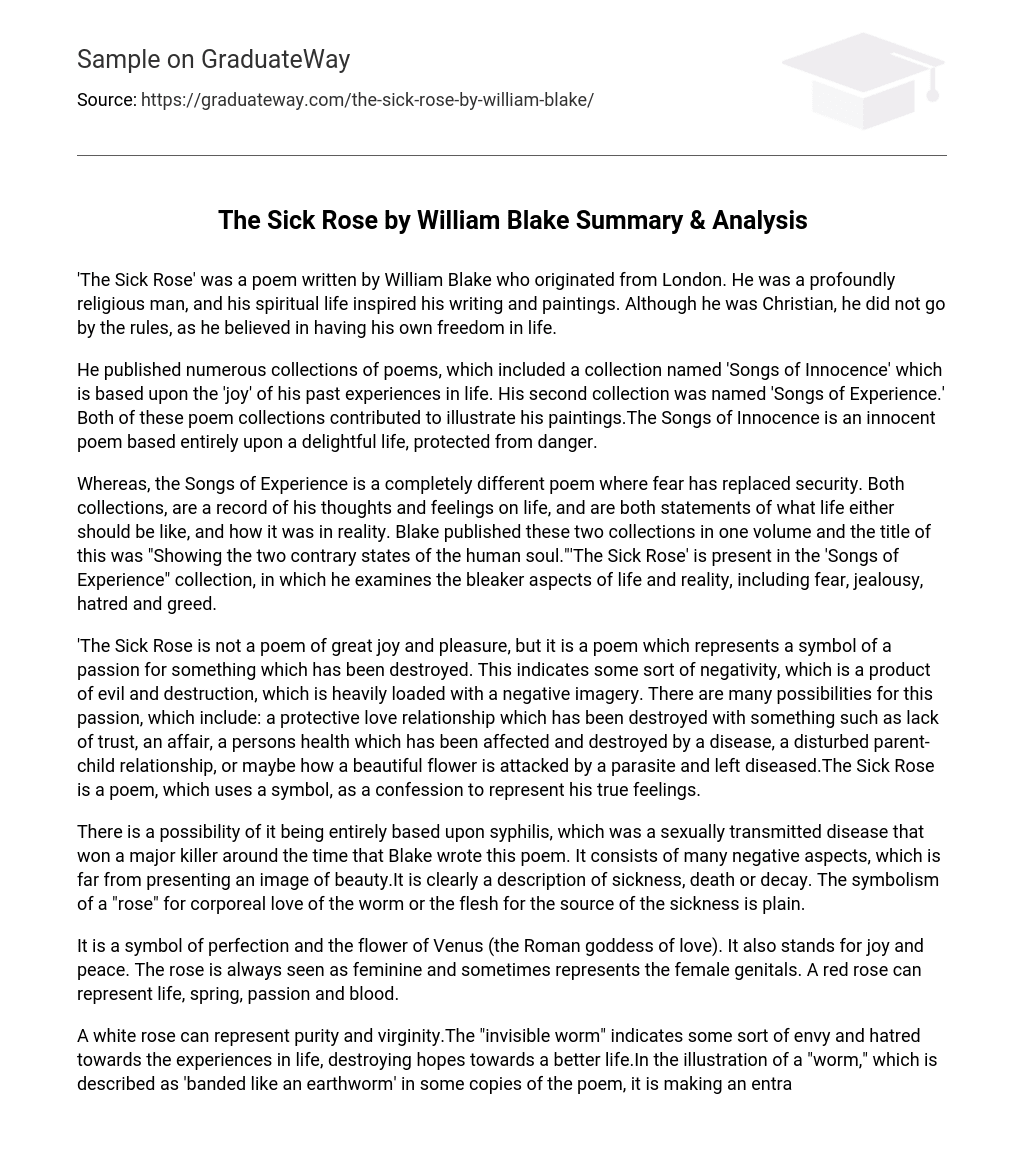‘The Sick Rose’ was a poem written by William Blake who originated from London. He was a profoundly religious man, and his spiritual life inspired his writing and paintings. Although he was Christian, he did not go by the rules, as he believed in having his own freedom in life.
He published numerous collections of poems, which included a collection named ‘Songs of Innocence’ which is based upon the ‘joy’ of his past experiences in life. His second collection was named ‘Songs of Experience.’ Both of these poem collections contributed to illustrate his paintings.The Songs of Innocence is an innocent poem based entirely upon a delightful life, protected from danger.
Whereas, the Songs of Experience is a completely different poem where fear has replaced security. Both collections, are a record of his thoughts and feelings on life, and are both statements of what life either should be like, and how it was in reality. Blake published these two collections in one volume and the title of this was “Showing the two contrary states of the human soul.”‘The Sick Rose’ is present in the ‘Songs of Experience” collection, in which he examines the bleaker aspects of life and reality, including fear, jealousy, hatred and greed.
‘The Sick Rose is not a poem of great joy and pleasure, but it is a poem which represents a symbol of a passion for something which has been destroyed. This indicates some sort of negativity, which is a product of evil and destruction, which is heavily loaded with a negative imagery. There are many possibilities for this passion, which include: a protective love relationship which has been destroyed with something such as lack of trust, an affair, a persons health which has been affected and destroyed by a disease, a disturbed parent-child relationship, or maybe how a beautiful flower is attacked by a parasite and left diseased.The Sick Rose is a poem, which uses a symbol, as a confession to represent his true feelings.
There is a possibility of it being entirely based upon syphilis, which was a sexually transmitted disease that won a major killer around the time that Blake wrote this poem. It consists of many negative aspects, which is far from presenting an image of beauty.It is clearly a description of sickness, death or decay. The symbolism of a “rose” for corporeal love of the worm or the flesh for the source of the sickness is plain.
It is a symbol of perfection and the flower of Venus (the Roman goddess of love). It also stands for joy and peace. The rose is always seen as feminine and sometimes represents the female genitals. A red rose can represent life, spring, passion and blood.
A white rose can represent purity and virginity.The “invisible worm” indicates some sort of envy and hatred towards the experiences in life, destroying hopes towards a better life.In the illustration of a “worm,” which is described as ‘banded like an earthworm’ in some copies of the poem, it is making an entrance to the heart of the rose, and simultaneously the spirit of this joy is extruded. It could also be a phrase used to possibly represent a serpent.
However it can also be used as a symbol of death. It is connected with lowness, vileness and contempt and it is a masculine force, sometimes being seen to represent the penis. In this poem, worm is also specifically the canker worm, which eats the roots of the rose.The rose from which the rose has bent down to the ground on the illustration of the poem presents several other details.
On the left is a caterpillar feeding on a leaf, the creature being for him, as for the Bible and Elizabethan poets, the symbol of the “pillager” or despoiler. Elsewhere, Blake denoted the caterpillar as the chief enemy of the rose, equating it with the priesthood, who lay their curses on the fairest joys. Further down the stems are two figures in attitudes of despair. The menacing thorns scattered along the whole length of the stems emphasise the pains of love on earth.
The worm flies in the “night” which may indicate some sort of ‘dark secret love’ that is linked to possessiveness and jealousy of love, which is eventually destroyed. It is a symbol of darkness, of things secret and hidden and also be used as a symbol of evil.The “howling storm in which the rose comes, suggests some sort of symbol of materialism. It is a symbol of chaos, confusion, fear, wildness, destruction and change.
The storm can also be seen as blowing away the old and frail and giving the new room to expand. If the storm is seen to have creative effects, there must first be great wildness and destruction.The term “bed” is a symbol of sleep and the vulnerability and innocence of sleep. It can also represent the sexual in bed.
In this poem it is also, of course, a garden bed.The “dark secret love” indicates something that is a secret and is hard to detect with great difficulty. The poem ends with the line “Does thy life destroy” which represents some sort of peace of mind of this specific scenario.In conclusion, it is obvious that William Blake is always a sharp contrast between the imagery of mutual love and the imagery of violence.





